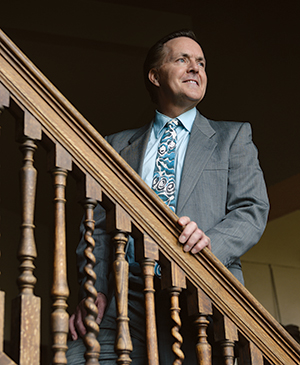
Writer: Christine Riccelli
Photographer: Duane Tinkey
Robert Warren steps gingerly around the rugs, lamps and Christmas ornaments in a corner attic at Hoyt Sherman Place. He carefully retrieves a brown paper parcel.
“I found this in a crawl space,” he says, peeling back the wrapping to reveal a 16th-century painting that’s been tucked in the shadows for decades. A faded auction tag identifies the work as “Apollo Teaching Venus to Paint” by influential Italian Renaissance artist and printmaker Federico Barocci (1526-1612).
The painting, which is now headed for restoration, isn’t the only thing that’s being refreshed at Hoyt Sherman. In fact, since arriving as executive director last October, Warren has been on a quest to revitalize and re-energize the entire venue—the theater and art gallery, as well as the historic home of Hoyt Sherman, a trailblazer of early Des Moines. Previously underutilized and underappreciated, Hoyt Sherman Place is experiencing a renaissance of its own, thanks to Warren’s impressive industry track record, sharp vision and relentless drive.

The number of ticketed events, for example, has more than doubled—from 43 to 87—this fiscal year (ending June 30) over the prior year. The result: Hoyt Sherman has gone from being in the red to generating a surplus. At press time, theater-related revenue, which makes up 70 percent of the budget, was nearly $150,000 above projections. In fact, as of April, Warren says, “we’ve had six months in a row of finishing above budget.”
And that’s just for starters. Warren also is making the Hoyt Sherman art gallery “more interesting and accessible,” as he puts it. A project to restore 48 of the organization’s 74 paintings was just completed, and now Warren plans to add explanatory signage to each piece of art in the collection.
Behind the scenes, Warren has launched a fundraising campaign to repair and upgrade the building’s heating, air conditioning and lighting systems as well as the restrooms—“all the non-sexy stuff that you can’t find donors for,” he says. That effort took a step forward in early May when Prairie Meadows approved Warren’s grant request and awarded $100,000 for the project. The goal is to raise $898,000.
Among other projects planned or in the works: building an addition to the backstage area; increasing the endowment fund; collaborating with other local arts organizations as well as arts education groups and the Sherman Hill neighborhood; using Hoyt Sherman’s expansive lawn for events and activities; and increasing the visibility of the historic mansion.
“My goal is to have the entire building open and accessible as many hours of the day and week as we can, re-engaging with the community in the process,” the 53-year-old Warren says. “I want to put Hoyt Sherman back on the relevance radar.”
Those who know Warren have no doubt he’ll meet that goal. “Robert is fearless,” says Linda Webster Machan, a mentor who was one of Warren’s middle school teachers in his hometown of Friendship, Wis. “If he has an idea, he doesn’t see any reason why he can’t get it done. There’s no saying no to him.”
Theater Operation
The biggest changes so far have been to the theater operation, which remains the primary draw of Hoyt Sherman Place. “For quite a few years, the theater had been treated strictly as a rental house,” Warren explains. So the venue “was at the whim of outside promoters if they wanted to stop in Des Moines for a show.”
When Warren arrived, however, he began booking shows directly, filling the calendar with acts such as Peter Frampton, Kacey Musgraves and Tears for Fears. He drew on contacts he had developed through his decades of being in the industry, including at such prestigious organizations as the John F. Kennedy Center for the Performing Arts.
When Hoyt Sherman invests in concerts and other events directly, it keeps more of the proceeds. But it also assumes the risk. To help mitigate that risk, the board created a $50,000 angel fund, which Warren says has been critical in making the model work.
Warren “came with deep and solid relationships with promoters and agents,” says Tom Slaughter, Hoyt Sherman Place Foundation board president. “He’s able to identify acts that are appropriate for us.”
Warren estimates that about half of the events and concerts will still come through outside promoters and half will be shows Hoyt Sherman books directly. No matter how the event is booked, though, Hoyt Sherman is taking a more active and aggressive role in marketing it. For outside promoters, “we jump in and help them sell out the event so they can maximize every dollar that they make,” he says.
That marketing role, which may include advertising, social media and other promotional efforts, extends to local arts and community organizations that rent the facility, such as Ballet Des Moines for its annual “Nutcracker” performance and dance schools for their recitals. “We want to keep all our anchor tenants, plus help them grow their audience,” Warren says. “The more they are able to be self-sustaining, the more everyone—artists, organizations, Hoyt Sherman, the community—wins.”
Civic Music Association will present its 2016-17 jazz series at Hoyt Sherman for the first time. (Its classical music performances will remain at Drake University’s Sheslow Auditorium.) The season launches with Manhattan Transfer and Take 6 performing together Nov. 5.
“There will be 14 or 15 performers onstage during the concert,” notes Peter Stevenson, Civic Music’s executive director. “Hoyt Sherman provides more flexibility for larger groups and is more appropriate for amplified ensembles” than Sheslow. In addition, the 1,252-seat auditorium has nearly 500 more seats than Sheslow, offering Civic Music the opportunity to increase its visibility and audience size, he adds.
“Robert was very accommodating, which helped make the decision to move our jazz concerts there easy,” Stevenson says. “He has a lot of experience and was willing to share negotiation strategies with me. … With Robert’s leadership and embrace of local organizations, Hoyt Sherman is making a leap forward.”
Performer and Audience Experience
Warren also is focused on ensuring performers have the type of experience that will motivate them to return. For instance, Lyle Lovett and John Hiatt, who performed there last October, played an hour longer than they were contracted for. “They raved about the beauty of the building, the acoustics and the audience,” Warren recalls.
“They said, ‘We want to come back. It feels so good here.’ ” Lovett, in fact, will return with his full band July 17.
For his concert on May 1, Graham Nash was so impressed with the acoustics “that he wanted to try something he hadn’t had the opportunity to do before,” Warren says. “He and his backup player unplugged their guitars, stepped away from the microphones, walked to the edge of the stage and sang a gut-wrenching rendition of ‘Stop all the Fighting.’ ”
Warren’s eventual goal is to construct an approximately $2 million addition to upgrade the backstage area of the 93-year-old theater. (The auditorium was refurbished in 2003.) As he shows a visitor the worn dressing rooms and coat-closet-sized bathroom, he explains that the lack of space and updated amenities, such as showers and a washing machine, can be a deal breaker for some acts, especially ones that don’t stay overnight.
The proverbial red carpet isn’t rolled out just for performers, though. The other key component to reinvigorating the theater lies in providing a memorable experience for the audience—starting with when they walk into the building, Warren says. For example, when he arrived, he found the lower-level lobby cluttered and unattractive, he says: “There were snow shovels and bags of salt in the entryway, and the lobby was crammed with big bulky chairs and ratty couches.” What’s more, a bronze statue of Joan of Arc—bought in 1893—“had been pushed into a corner behind the trash receptacle.” He had the lobby cleared and cleaned and moved the statue to an alcove to showcase it, making the area more inviting.
Such small touches can make a difference in people’s impressions of the place, especially if they haven’t been there for a while. “We want to reintroduce Hoyt Sherman to people who may not have been there since their child’s dance recital or even their own dance recital,” Slaughter says. “There’s a lot of energy and excitement at Hoyt Sherman Place right now.”

After languishing in a corner behind a trash receptacle, this bronze statue of Joan of Arc by Ferdinand Barbedienne is now showcased in Hoyt Sherman Place’s lower-level lobby. The Des Moines Women’s Club purchased the statue in 1893 at the World’s Fair in Chicago.
Art Gallery
That reintroduction goes beyond the theater to include the art gallery. Warren is eager to re-energize the space and showcase the art, and the stories behind the works, with more people, including as many school groups as possible.
The Des Moines Women’s Club built the gallery as an addition to the home in 1907 as the city’s first public art museum. The collection grew to 74 paintings and 35 sculptures by such noted artists as Edwin Lord Weeks, Carl Frieseke, Thomas Moran and Del Varoccio. In May, a project begun in 2012 to restore much of the collection was completed, and Warren has applied for a $41,000 grant that would fund research and signage for each piece. He also plans to rotate the works more frequently and eventually host visiting exhibits.
Perhaps even more off the public’s radar is the 1877 home of Hoyt Sherman. Tours take visitors through eight rooms of the mansion. As with the theater and art gallery, Warren has immersed himself in discovering every detail about the space—and in enthusiastically sharing what he’s learned.
He points, for example, to a hand-painted fireplace screen in the dining room. “I love to ask kids what they think the screen was used for,” Warren says. “They usually say, ‘Well, to keep the fire in.’ And I say, ‘Nope, that’s not it.’ ” Back then, he says, women wore wax-based makeup, which was prone to melting. When women sat by the fireplace, the screen helped prevent the meltdown.
Stronger Financial Footing
In the past, Hoyt Sherman management has drawn on the $4 million endowment to maintain the structure—as well as to cover operating expenses when there were budget shortfalls. Warren is changing that formula and that expectation: In addition to generating more revenue through theater bookings—he estimates the combined operations will generate around $1 million next fiscal year, up from an expected $850,000 this year—Warren is spearheading more active fundraising than in the past, including writing grant requests.
“Four million is great to have in the endowment, but when you consider the size of this place and what the insured replacement value is, that could be gone in a heartbeat,” Warren says. “So I’m being as aggressive as I can to reverse the trend of drawing on the interest, instead working to build the endowment up.”
In late April, the Hoyt Sherman board voted to end the management contract it has had with VenuWorks for the past decade; all operations have moved in-house. Board president Slaughter explains that, during the 2003 renovation, the theater was out of commission. Afterward, he says, “there was a struggle to get it kick-started again. As a way to move forward, VenuWorks was hired to bring new acts and events to Hoyt Sherman.”
The arrangement worked well, but over the past few years, “the board recognized that the reason VenuWorks had come on board had passed,” Slaughter says. Specifically, VenuWorks now focuses on managing larger, for-profit facilities. “In VenuWorks’ array of facilities, Hoyt Sherman Place was the only nonprofit and the only historic venue with a mansion, museum and theater. The things we were searching for went beyond what VenuWorks could provide, and we both recognized it was no longer the right fit.
“A big part of our ability to do this is Robert,” Slaughter adds. “He came here with the background, skills and interests that fit perfectly with Hoyt Sherman Place.”
Beyond that experience, though, “is his personality,” Slaughter says. “He has the ability to connect with people at all levels.”
Warren has the rare ability to be both an artist—he spent years as an actor—and a savvy businessman, says Karyn Kennedy Herterich, who worked with Warren to revive and expand a theater in Blowing Rock, N.C., and later persuaded him to join the Kennedy Center. “He’s very good at engaging people, particularly at disarming them with his humor. He has the most incisive wit of anyone I’ve known.
“People in the arts can be very emotional—the arts by nature evoke emotion,” she adds. “Robert has the ability to make people stand back and relax. ”
One for All
Warren’s vision for Hoyt Sherman Place goes beyond its doors to embrace other arts organizations, the Sherman Hill neighborhood and the metro area’s schools. He views the city’s theaters as complementing one another rather than competing. “Des Moines is fortunate that the theaters aren’t all the same size,” he says. “In a lot of cities, there may be five 1,000- or 1,500-seat theaters, and all of them will struggle.” But Des Moines’ theaters range in size, from, for instance, the Des Moines Social Club’s reconfigurable Kum & Go Theater, which can seat 150 to 225 people, to Hoyt Sherman’s 1,252 seats to the 2,700-seat Des Moines Civic Center.
“As the two theaters have different seating capacities, the Civic Center and Hoyt Sherman complement each other very nicely, allowing artists and shows to play to the right audience,” says Jeff Chelesvig, president and CEO of Des Moines Performing Arts, who has known Warren for years. “We regularly trade information about touring acts, and over the past five years, Des Moines Performing Arts has collaborated with Hoyt Sherman Place to co-present several shows.”
Warren also wants Hoyt Sherman Place and the Sherman Hill Neighborhood Association to work together, as in the two groups’ current plan to show a film this summer on the lawn.
As Hoyt Sherman’s visibility increases, Warren says he hopes the venue becomes a planned destination “where you come to see the artwork, go through the mansion, see a show, hang out on the lawn. … No matter what the time of year, the doors should be open, the lights on and things always happening at Hoyt Sherman.”
The Road to Des Moines
At one time in Robert Warren’s hometown of Friendship, Wis. (population 725), most kids figured they faced one of two destinies: working on a farm or working at the paper mill. Only about 60 percent of high school students graduated; in fact, Warren was the only one of four siblings to finish high school, let alone go to college.
He credits a special arts-infused educational program, initiated when he was in middle school, for making the difference. The arts were used to teach skills in every discipline, such as geometry through constructing theater sets and science by making paint. The result: His 1981 high school class had a 93 percent graduation rate, and 85 percent of the graduates pursued higher education.
With an interest in theater, Warren headed to New York City and a two-year training program for actors at the American Academy of Dramatic Arts, then earned a BFA from Marymount Manhattan College, specializing in musical theater.
For seven years, Warren performed with touring shows, including “The Pirates of Penzance” and “The Best Little Whorehouse in Texas.” In 1988, weary of constant travel and with the arts economy struggling, he joined an Army program that provided an education and a job in the White House communications department. After earning a BFA in radio, TV and film from the University of Maryland, he says, “I was ready to launch into a life in Washington, D.C., and found myself a single father,” with full custody of his two young sons, Christopher and Robert.
Shunning the high costs and long commutes of Washington, D.C., Warren and his boys moved in 1995 to Cedar Falls, Iowa, where he oversaw the renovation and revival of the Oster Regent Theatre. The project “helped revitalize downtown Cedar Falls,” he says. “As soon as the theater reopened, stores started opening. … I realized how an arts-related center could be a catalyst for change.”
Three years later, he was off to Blowing Rock, N.C., to save another theater on death row. Within a year, a $40,000 deficit had turned into a $100,000 surplus. The turnaround was so successful that a new, larger theater was built.
That achievement led him back to Washington, D.C., for a nine-year stint at the John F. Kennedy Center for the Performing Arts, a leap from a “very small fish pond to a shark tank,” says Karen Kennedy Herterich, who worked with Warren in Blowing Rock and introduced him to Kennedy Center leaders. “If you can survive a decade at the Kennedy Center, you can survive anywhere. … Robert was able to thrive by taking his sense of humor and his wildness and blending them with his administrative abilities.”
While there, Warren was the associate producer of “Shear Madness.” He also was executive director of the Kennedy Center’s Any Given Child initiative for Sarasota, Fla., which assists communities in developing arts-infused educational programs. Sarasota was one of 10 sites selected to model the program. In 2013, Warren left the Kennedy Center to lead Hartford Performs in Hartford, Conn., a public-private partnership that uses an arts-integrated curriculum to boost academic progress. Within three years, reading and writing skills among participating students jumped 8.6 percent and visits to the principal’s office dropped 25 percent.
Ultimately, Warren decided to return to the Midwest, seeking to be more directly involved with the performing arts. “As I reflected on my experiences, the one I loved the most was the feeling in Cedar Falls of really connecting with the audience and the community,” he says. He also wanted to work in a multiuse facility.
Hoyt Sherman Place fulfilled all those goals. “I never imagined something as spectacular as this, where it’s a mansion and a gallery and a theater and even a lawn,” he says.
“I mean, Hoyt Sherman is everything.”
Over the past fiscal year, the number of ticketed events at Hoyt Sherman Place has more than doubled, from 43 to 87. Warren has booked a range of performers, including country, rock and comedy acts.















